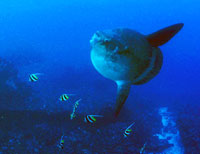
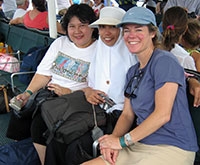
Tresnati, Aidah and Tierney (WISC recipients)
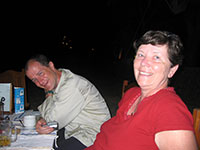
Jamie and Jackie tagging volunteers
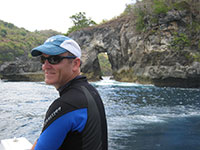
Brett Hobson marine engineer extraordinaire
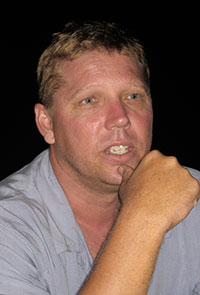
Michael Cortenbach
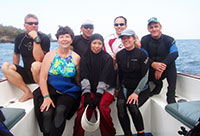
Dive team from left to right Top Michael Cortenbach, Jos
Pet, Mark Erdmann, Brett Hobson
Lower Jackie Guccione, Aidah Hussain, Tierney Thys
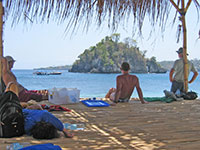
Resting between dives
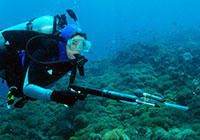
Chasing the mola
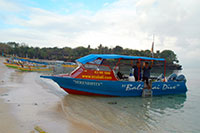
Dive boat
|
|
September 2004
We just returned from an expedition to Nusa Lembongan—a tiny
island in South East Asia off Bali, Indonesia where the
giant ocean sunfish, Mola mola, come to indulge
in the ultimate spa treatment—fish style. Between 20 and
50 meters, mola emerge from offshore waters close to the
reef and solicit the exfoliating, cleaning services of
fishes like butterfly fish Heniochus diphreutes and Chaetodon
kleinii as well as wrasses like Labroides dimidiatus and Thalasoma
lunare and adult emperor angelfish Pomacanthus
imperator. The mola tilt their bodies backwards and
just hang nearly motionless in the water column letting
the little piscine cleaners work their magic on the mola’s
veritable smorgasbord of parasites. For more on this cleaning
behavior see Konow
et al (2006) .
The trip was a truly exciting one punctuated by a number
of noteworthy events. The day we landed, a suicide bomber
blew up a car in front of the Australian embassy in Jakarta,
killing nine people and injuring dozens of others. The bombers
are thought to be from a group called Jemaah Islamiah, a
regional network of militants bent on establishing a pan-Islamic
state across Southeast Asia. While it’s the third bombing
in two years, radicalism is really rare among the some 240
million people of Indonesia. Midway through the trip we had
a 5.5 earthquake that made me feel quite at home since I
live in California. And the day we left, Indonesia had its
very first democratic elections and voted retired military
general Susilo Bambang Yudhoyono into power.
This trip was funded in part by a AAAS Women International
Scientific Cooperation (WISC)
grant to myself, Tierney Thys and Heidi Dewar and two Indonesian
women scientists, Aidah Husain and Joeharni Tresnati from
Hasanuddin University located in Southern Sulawesi. One
of our partners, Aidah Husain, is orthodox muslim and SCUBA
dove the entire time in full head scarf and loose fitting
clothes over her wetsuit. Didn’t slow her down a bit. Ambo
Tuwo was also instrumental in helping this expedition take
place. The National Geographic Society provided additional
funds.
Trip logistics were made possible by the
tremendously gracious help of Michael Cortenbach and his
staff at Bali
Diving Academy including videographer
and mola whisperer Chris Papporakis. Also helping were the
renowned marine engineer Brett Hobson, the very competent,
long time Indonesian underwater faunal experts, Jos Pet and
Mark Erdmann along with their amazing families and two eager
volunteers from the UK and the US, Jamie Watts and Jackie
Guccione respectively. Tim
Rock, photographer extraordinaire, documented the trip beautifully.
This was the first time we’d ever been required to hunt
mola at depth. Typically we tag topside since mola
in temperate waters tend to bask on the ocean surface—a behavior
that, in fact, has earned them their common name of sunfish.
In tropical waters however they’re not seen as frequently
on the surface. They do however occasionally breach—clearing
the water by a body length or two before slapping back down--a
behavior most likely due to cleaner fish getting a little
too personal. Breaching may also simply be another way to
remove parasites from the skin. And boy oh boy do mola carry
a heap of hitch-hikers.
To tag we used a pneumatic speargun, specially designed
by Brett Hobson, and snuck up on the mola using SCUBA gear.
Time is limited at depth so if the fish weren’t there, we
just had to come up and try again later after decompressing.
And try we did. Whew, I thought we’d never get a tag out.
A number of factors came into play. Firstly as mentioned
above, this lovely place has been discovered by tourists
so large numbers of divers descended upon our various tagging
sites at fairly regular intervals making it difficult for
the mola to settle into a comfortable cleaning posture required
for precise tag deployment. In addition, a BBC film crew
including expert videographer Peter Scoones and AP Emma Rolfe
was filming the same mola for the Planet Earth series. Lots
of people wanting mola and not so many mola to go around.
In the end, everyone got what they needed. We got a tag out
and the BBC got a lovely sequence. Incidentally if you want
to see the mola we tagged, check out Planet
Earth’s Ocean Deep episode.
We did have to leave one tag behind along with the speargun
since our time ran out but we knew it was in good hands.
Within several weeks later, a jubilant email came from Michael
Cortenbach reporting that he had gotten the second tag out
on another mola.
Working with these mola underscored the
need to clearly inform the growing numbers of tourist divers
and dive operators how to dive non-invasively with these
magnificent animals. To that end after we returned home,
we worked with the folks at Bali Hai Diving Adventures,
particularly Chris Lamont, and established a voluntary Code
of Conduct for divers in
order to preserve this unique dive experience.
We are also hopeful that our tagging work here, while in
its infancy, can help create momentum to further marine protection
efforts for the waters of Bali and beyond.
|

